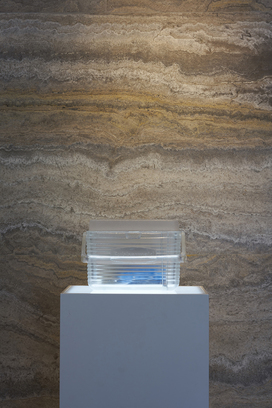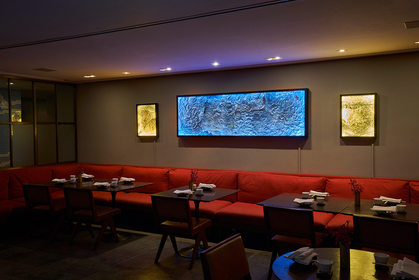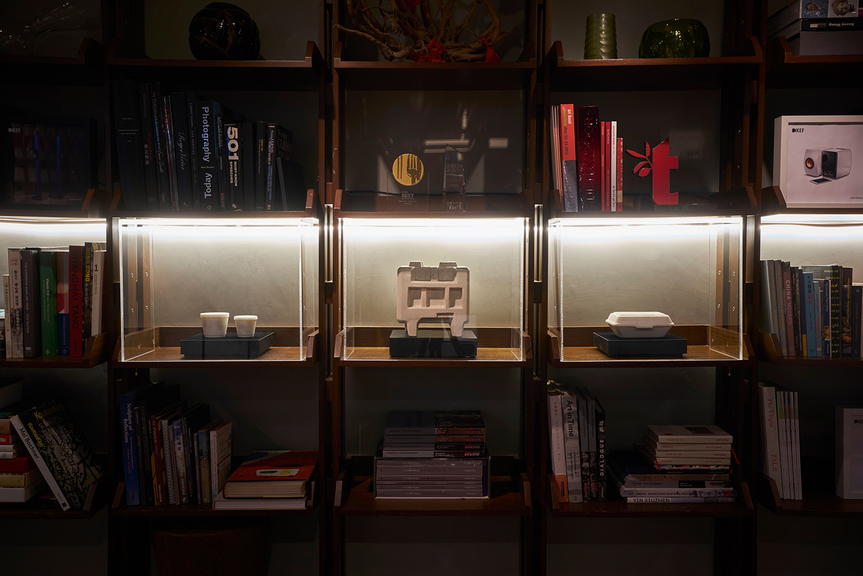-
From Current Issue
-
- Editor’s Letter Fire in the Heart
- Reviews I Gusti Ayu Kadek Murniasih
- Reviews 11th Seoul Mediacity Biennale: “One Escape at a Time”
- Dispatch Networked China
- One on One Monira Al Qadiri on Yukio Mishima
- Essays The rise of independent art spaces in pandemic-era Shanghai
- Features Tuan Andrew Nguyen
- Table of Contents
- Web Exclusives
- Archive
- Subscribe

R
E
V N
E
X
T
The quest for hygiene involves cleaning detergent, yet too much of it may make one nauseous and sick. In a similar paradox, the act of cultural preservation exists alongside the hoarding of packaging materials, conservation documents, and even objects. In “The Preservationists,” a group exhibition of 11 artists, the 22 works brought together by curator Ingrid Pui Yee Chu presented a site-consciousness bordering on site-specificity, across a wide range of architectural surfaces in Hong Kong’s elegant restaurant-slash-social-club, Duddell’s. Rejecting the decorative aesthetics that such plush décor and commercial functionality anticipate, these works articulated our sensitivity to materiality, revealing the discomfort that common or everyday objects often evoke.
An operational restaurant runs on the need for order and cleanliness, for liquids to be contained and food to be savored in a hygienic setting. However, upon entering the main salon, viewers were confronted with an eerily glowing emerald liquid encased within an IV bag, inside a transparent urethane icebox. This is a work by US-based artist Josh Kline, titled Essence of Bitter Melon (2015). Although the fluid—green Dettol floor cleaner infused with powdered Indonesian rupiah—is safely contained in an IV bag, the threat of toxic hazard was still present, highlighted by the medical context of the containers and waiters carrying trays of food dangerously close to the object. Its blue-laundry-detergent counterpart, Sleeping Under the Kitchen Table (2015), also by Kline, was installed across the salon, and similarly projected an unsanitary scenario. Other toxic ingredients in the space included three lightboxes from Hong Kong artist Andrew Luk’s “Horizon Scan” series (2017), which feature illuminated collages of napalm-burnt canvases.
Though inert, these works contained entropic potential, which threatened to unleash itself spontaneously. Tucked into the bookshelf of the library was Sterling Ruby’s Ashtray 413 (2016), a high-fired ceramic sculpture with thick layers of black and red iron-rich glaze which resemble the molten and ashen lava of a volcano. Next to this was Taiwanese-Canadian artist An Te Liu’s Brutalist Rice Cooker (2013), a cuboid stoneware sculpture composed of geometric undulations, similar to the interior weave of cardboard boxes, and finished with a crackle glaze. The refined Brutalist is the polar opposite of Ruby’s crudely-formed work, and its faux-archaic, cracked surface expresses a tension between complete disintegration and resilience against such destruction.
This stoicism towards material fate was matched by Canadian artist James Carl’s works on the same row in the bookshelf, which also relayed a resistance to obsolescence. Works from his “Takeouts” series (1995– ) comprises marble sculptures modeled on Styrofoam takeout containers, while Empty Orchestra (Walkman) (1995) is a Walkman crafted out of black jade. Created during Carl’s time in Beijing in 1995, this ongoing set of works expresses a nostalgic charm, immortalizing the anachronistic forms which have faded from everyday life.
On the wall across from the neat bookshelves was Hong Kong-based Lee Lee Chan’s Absorber #2 (2017), a sculptural installation made from asphalt found in the streets of her home city. Originally paved to absorb egregious weight and noise from lorries and traffic, these tired asphalt shards crumbled to pieces after they reached their functional capacity, and were reworked by Chan into a glittering circular wall sculpture that restored the monumentality of the road.
Bringing these works to an exhibition in an environment that emulates, in Duddell’s own words, the “eclectic home of a seasoned art collector,” is no small feat in itself. Chu sourced ten works from prominent local and international collections, seven from regional and international galleries, and the remaining five works were specially commissioned or on loan directly from the artist. The coming together of this ensemble embodies a multitudinous network that references the spatial, aesthetic and psychological consequences of the global art system of citadel-like art storage units and the clinical art fair-industrial complex, as well as the conditions of Hong Kong, with its overcrowded urbanism, choreographed chaos and scarcity of art spaces.
Installation view of ANDREW LUK’s “Horizon Scan” series (2017), epoxy resin, polystyrene plastic, canvas, LED lights, dimensions variable, courtesy the artist and de Sarthe Gallery, Hong Kong; and JOSH KLINE’s Sleeping Under the Kitchen Table (2015) (left) and Essence of Bitter Melon (2015) (right). Courtesy the artist.
Within the exhibition’s exuberant excess of textures and materials was one question: What separates a hoarder from a collector? Is it in the quantity of objects owned and stored, which might dwarf the select few that are actually visible to the public? Is it in one’s unconventional way of treasuring objects that might otherwise be deemed useless, uninteresting or burdensome? Or is it an inability to process and thus let go of emotions, memories, and their relative objects? The answers, found in the show, is that there are subjective similarities and differences between the moral decadence of an addict and the obsessive compulsion of a scavenger.
In his 1931 essay Unpacking my Library, Walter Benjamin wrote, “Every passion borders on the chaotic, but the collector’s passion borders on the chaos of memories.” In rebellion of the minimalist, ahistorical, modernist tabula rasa of the white cube, “The Preservationists” presents a hoarding of tangible memories that are found in the city’s material fragments.
“The Preservationists” is on view at Duddell’s, Hong Kong, until March 21, 2018.
To read more of ArtAsiaPacific’s articles, visit our Digital Library.







